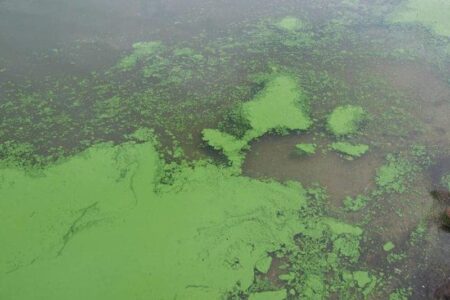Maintaining control over pond weeds can be a challenging task. The first step to finding a suitable solution is the correct identification of the specific weed. The majority of ponds have separate types of plants and you do not want to begin the incorrect treatment for these weeds. Some pond plants are not merely weeds but are beneficial to migratory and local wildlife; you will not want to remove these “good weeds”.
While there are several types of aquatic weeds, the positive news is that pond weeds are easier to identify when compared with turf grass and pasture weeds. There are four main types of pond weeds including submerged weeks, floating weeds, emergent weeds and algae. This article will discuss each of these plants.
#1: Pond Algae
Certain types of algae are microscopic, such as planktonic algae; however, there are other types of algae that are large and resemble other plants except they lack and plant roots. Algae is one of the most common problem plants without any defined root systems. This plant typically floats on the pond surface in groups, although it might emerge at the pond bottom before heading to the water surface.
Moss, also known as filamentous algae, can cover the bottom area of the pond along with algae clumps floating to the surface. It appears as a moss “blanket” floating on the surface of the pond resembling wet wool. Moss is a form of algae often known as “pond scum”, string algae or floating algae. If left alone, the moss can cover the full surface of the pond. One form of filamentous algae is Oscillatoria, also known as black algae. This can lead to a reddish-purple tinge in the water.
Chara looks similar to submerged weeds but are differentiated by the musky smell. This type of algae is found on the bottom of the pond in large pillows making it frequently referred to as weeds. Chara is unique because it does not grow on the surface of the water and results in a crunchy texture.

#2: Emergent Pond Plants
An emergent plant is a type of rooted plant often found along the shore. The plant stands above the water surface, similar to cattails. Emergent plants tend to have stiff or firm stems.
Some of the more common emergent weeds include smartweed, water pennywort, and alligator weed. The alligator weed is a dense form of plant with a mat appearance making access to the shoreline difficult. The stems are hollow, but the leaves are fuller with a prominent mid-rib. Flowers of the alligator weed is white, small and placed on long branches similar to white clovers.
The water pennywort typically forms mats along the shoreline; however, it can also appear as an island or floating mat. The leaves of the pennywort are dark green with blunt indentations from the center of the stem. Greenish-white flowers with five petals are found on one point of the stalk and their small size represents four-leaf clovers.
Smartweed grows up to three feet in length amidst the shallow waters. The stems are jointed and are, on average, four inches long with alternative leaf protrusion. The flowers change color as they mature ranging from green to white or light pink.

#3: The Floating Pond Plants
Floating plants are characterized by a lack of attachment to the water bottom. Floating plants are available in all sizes ranging from smaller weeds, like duckweed, to plants over one foot in diameter. The majority of roots hang in the water from the plant’s green portions; for instance, a duckweed has a dense blanket covering the surface of still ponds. The floating plant ranges in color from dark to light green and present with a flattened structure on which roots and leaves grow.

#4: Submerged Pond Plants
One of the most detrimental of submerged plants is the Hydrilla – a submerged week. The hydrilla grows quickly presenting leaves that are long with serrated edges. Flowers can grow from the plant’s upper branches but they are translucent in color. The coontail is a rootless plant and can reach approximately fifteen feet in height. It is available in dense colonies and the branches are rough to the touch. Eurasian milfoil is one of the exotic submerged plants and reproduces using both seeds and vegetation.
Original Content Source: lakemanagementinc.net






